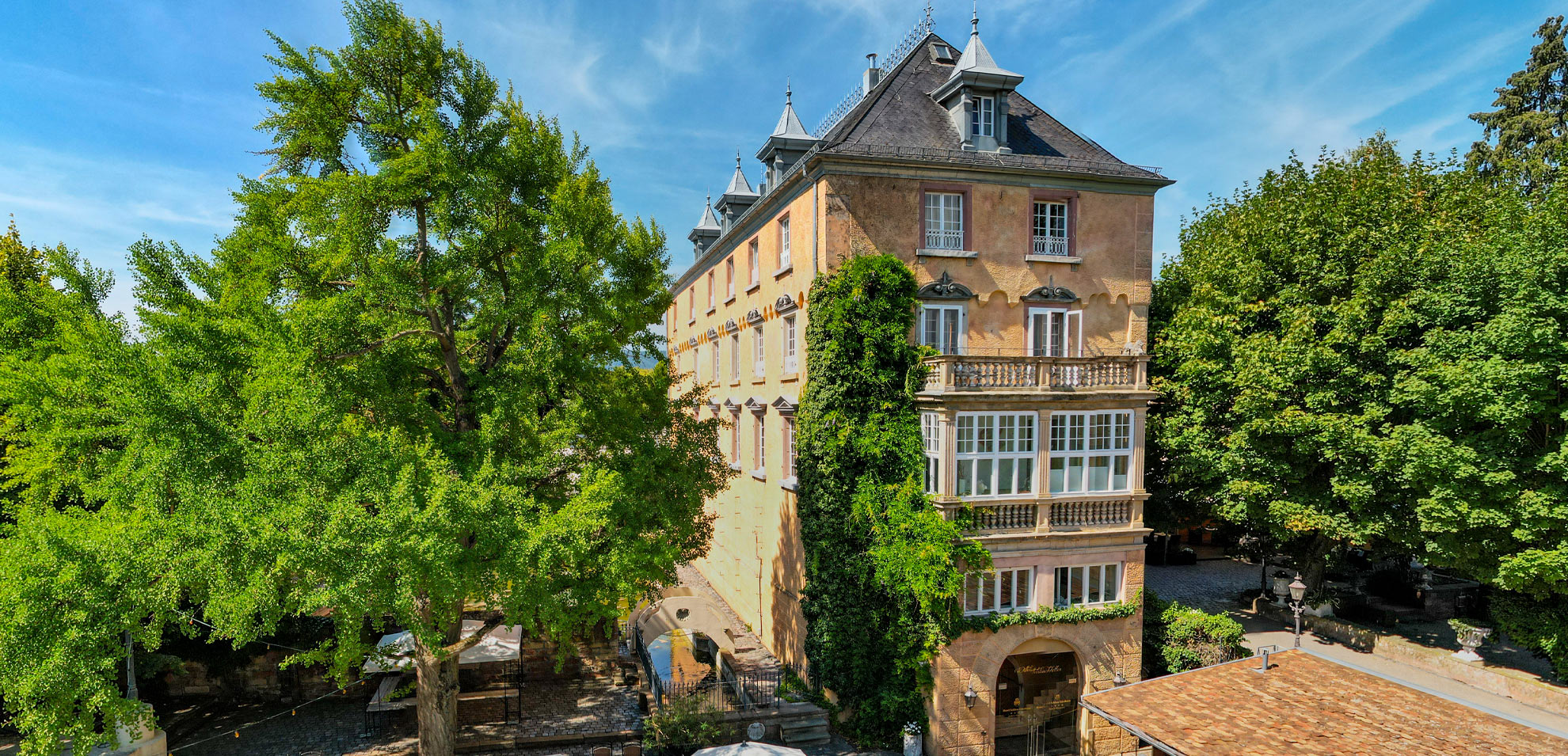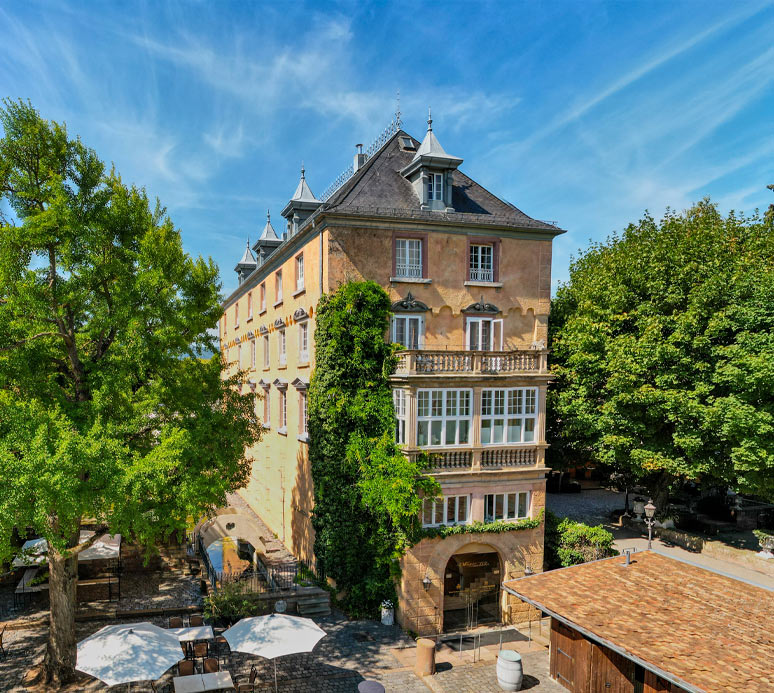

THE HISTORY OF EDESHEIM CASTLE
“The Palatinate is a vowed land to be reckoned against other lands and all is well in our dear fatherland…the Palatinate is richly blessed among the lands of the earth” raved Liselotte of the Palatinate in Versailles of the beloved lost homeland. There is no doubt that the most famous Palatinate woman of all times would have preferred to live in sunny Edesheim Castle a thousand times rather than at the court of the Sun King.
And it was Bavarian King Ludwig I who enthused: “Abode of my youth, Palatinate, I love you and you Palatines like you love me. I want to move home there with my loved ones one day…” and fulfilled his dream of building a summer residence “in the most beautiful square mile of my kingdom”. In this chosen spot – on a magnificent area, surrounded by vineyards and an enchanted park – one of the most beautiful castle hotels in German lands can be found in the middle of the warmest region of Germany: HOTEL SCHLOSS EDESHEIM
First documented by the Benedictine Abbey of Weissenburg in 756, the origins of the “fairytale castle” go back to the time after the Frankish land seizure. If it was the Christian clergy who laid the foundation stone for the construction, the clergy also led the castle to its first flowering and made the estate a haven of learning as well as an important administrative center in the Middle Ages.
After an intermittent decline in the 16th century, after plundering and destruction in the Peasant Wars, the castle together with the village of Edesheim came into the possession of the prince-bishops of Speyer in 1483.
Under the aegis of the church princes – at the same time secular rulers in the high diocese of Speyer – the castle served as an official residence and prince-bishop’s bailiwick. A hundred years after the Edesheim castle was built (1594), it was finally destroyed by the French during the Palatinate War of Succession – and then rebuilt from scratch.
The stately home has been documented as a moated castle since the 15th century, with the origins of the water installations dating back to the 12th century. How the castle presented itself to its visitors in feudal times can still be easily understood today. Adjacent to today’s main house there was once a rectangular transverse building, which served as a manor house as well as a residential and guest house. After demolition in 1748, a contemporary reconstruction with tower design took place in the 19th century.
Since the Middle Ages, the castle building, located in the plain, was enclosed by a wide moat to protect it from enemy attackers. The latter was designed in the form of a pond. From the outer castle path, visitors passed over a drawbridge into the inner district. It was not until the 19th century that the drawbridge was replaced by the fixed stone bridge that still exists today. From the place to the east there used to be a second moat in the form of a horseshoe, which also secured the farm buildings (today the residence) in a large arc. Further, in the history there were other drawbridges at the intersections of the castle path. These served as control and customs posts for the collection of road tolls on the thoroughfare between Neustadt and Landau. Today, the old branch canal, which used to feed the castle ditches and branched off from the mill stream near the nearby village mill, is also still clearly visible. The old canal ran parallel to the wall that separates the castle grounds from the houses below the village mill. The neighboring area of the so-called “Kupperwolf Castle” (once the home of the Palatinate winegrower’s son, who was born in Edesheim and became famous as a French encyclopedist and was raised to the nobility, Baron de Holbach) belonged to the castle in ancient times, as did several other former neighboring servants’ quarters.
The Edesheim castle is surrounded by a strong perimeter wall with a total length of about two thousand meters. In their course, “Staufer Behau” as well as the use of wall ashlars can be recognized. Masonry techniques and stone material allow to draw conclusions that in the course of many centuries this wall was built again and again. A document stone found in the castle wall shows the year 1570, but much older parts can also be found. Edesheim Castle – situated in a spacious area surrounded by vineyards and an enchanted park – has seen people and times come and go in the course of the now approximately 1250 years since its foundation stone was laid, experienced rise and fall, destruction and reconstruction, war and peace.
Owned by the church for centuries, the castle was nationalized in 1804 under Napoleon as part of secularization and from then on passed into changing private ownership. Towards the end of the second millennium, the old castle underwent a complete renovation. After an extensive renovation phase, the “Hotel Schloss Edesheim”, which was awarded a four-star rating, was created. A part of the castle moat with a water surface of about 500 square meters and with a water depth of 2.20 meters was newly rebuilt. This ditch is fenced by a footpath and a footbridge. The path leads around the castle to a magnificent open-air theater, whose permanently installed stage is designed in the form of a lake stage and impresses. About a thousand visitors can be seated on semicircular rising theater tiers, which gives the viewer the impression of an ancient amphitheater. A cultural site has been created here, which is a credit to the region of the Southern Wine Route as well as to the entire Palatinate.
Edesheim Castle – founded in a historical tradition, preserving the old in a contemporary form, and yet at the same time shaping the present – is of great identification value for the Southern Wine Route region, and today is known far beyond the borders of the Palatinate. Surrounded by Mediterranean flair and offering a very special ambience inside, Schloss Edesheim combines the courtly charm of feudal splendor with the most modern comfort, which meets even the highest demands.
With the new millennium, a new era began for the old “fairytale castle of the Palatinate”. In 2001, Hotel Schloss Edesheim came under the ownership of the Dr. Lohbeck group of companies. In addition to a few other hotels in historic buildings – such as Trendelburg, which is located on the German Fairy Tale Route – these also include senior citizens’ residences and newspaper publishing houses.
Dr. Rolf Lohbeck’s credo: “In order to successfully shape the future, one must look at and understand the past!” is reflected not least in the hotel concept of the group of companies.
CONTACT
Privathotels Dr. Lohbeck GmbH & Co.KG
Hotel Edesheim Castle
Luitpoldstraße 9
67483 Edesheim
Phone 06323 – 94240
E-mail: info@schloss-edesheim.de
PRIVATE HOTELS DR. LOHBECK
SOCIAL MEDIA

